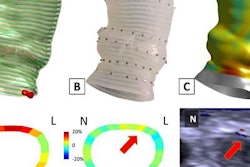Researchers have developed technology that can use a smartphone camera to measure left ventricular ejection fraction (LVEF) of the heart, potentially providing the same measurements generated with echocardiography, according to a study published in the journal Critical Care Medicine.
The technology assesses LVEF by measuring the amount that the carotid artery displaces the skin of the neck as blood pumps through it, describing the movement as a waveform. This signifies the expansion and contraction of the artery walls.
The technology was developed by Mory Gharib, PhD, from the California Institute of Technology (Caltech), along with researchers from Huntington Medical Research Institutes and the University of Southern California (Crit Care Med, July 2017, Vol. 45:7, pp.1115-1120).
LVEF is a key measure of heart health, and although the gold standard for measuring it is MRI, due to the modality's high cost and limited availability, LVEF is most commonly assessed via echocardiography, the team wrote. An echocardiography exam can take up to 45 minutes.
To test the technique, Gharib's group recruited 72 volunteers between the ages of 20 and 92 and conducted the study at an outpatient MR facility. The team held iPhone 5 smartphones running the application against volunteers' necks for two minutes; then the volunteers underwent an MR exam.
The researchers compared data from both tests and found that the measurements made by the smartphone had a margin of error of ± 19.1%, compared with those performed on an MRI. (In comparison, the margin of error for echocardiography is ± 20%.)
"What is exciting about this study is that it shows our technique is as accurate as echocardiography at estimating LVEF when both are compared to the gold standard of cardiac MRI," Gharib said in a statement. "This has the potential to revolutionize how doctors and patients can screen for and monitor heart disease both in the U.S. and the developing world."



.fFmgij6Hin.png?auto=compress%2Cformat&fit=crop&h=100&q=70&w=100)




.fFmgij6Hin.png?auto=compress%2Cformat&fit=crop&h=167&q=70&w=250)











